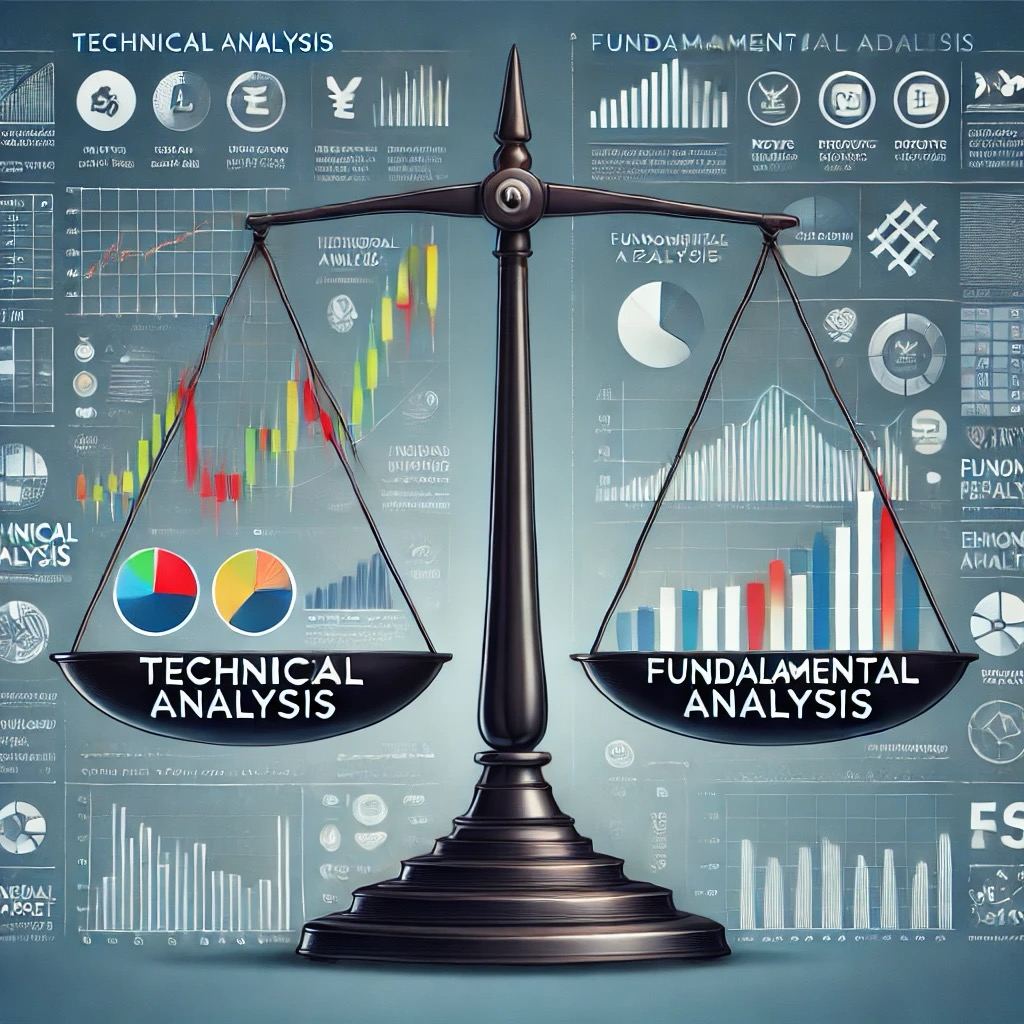Learn Trading for Free and Without Registration
An Online Glossary to Study Trading Independently
Fundamental and Technical Analysis of Forex

Market Analysis: The Foundation for Successful Investing
Investing in financial instruments requires a thorough understanding of market conditions. Whether you are exploring Forex, the stock market, commodities, or cryptocurrencies, success largely depends on effective analysis. Two primary methods of analysis widely used across all markets are fundamental analysis and technical analysis. Each has its own features, strengths, and limitations, but their combined application often yields the best results.
Fundamental Analysis: Examining Economic and Political Factors
Fundamental analysis focuses on identifying market trends by analyzing political, economic, and social factors. The goal is to understand which events or changes drive price movements and predict future developments.
What Does Fundamental Analysis Cover?
-
Economic Indicators:
- GDP (Gross Domestic Product): This is a key measure of a country’s economic health. Higher GDP growth signals a robust economy, which can strengthen a national currency or boost company stocks.
- Interest Rates: Central bank decisions to raise or lower interest rates directly impact currency values, bond prices, and corporate borrowing costs.
- Inflation: Moderate inflation is normal, but sharp increases or decreases can significantly influence markets.
-
Political Stability:
Political crises, elections, revolutions, or conflicts can lead to market volatility. For instance, changes in U.S. trade policy often affect stock prices, oil, and gold. -
Corporate Reports:
On the stock market, analyzing a company’s financial reports helps investors evaluate its performance. Metrics such as profit margins, revenue, and debt levels play a crucial role.
Markets Where Fundamental Analysis Is Essential:
- Forex: Currency stability is tied to the economic health of a country, with fluctuations often driven by news on interest rates or employment data.
- Stock Market: Stock performance is directly linked to corporate earnings and macroeconomic trends.
- Commodities: Prices for oil, gas, gold, and metals are affected by global events, including supply-demand dynamics and geopolitical factors.
Technical Analysis: The Art of Reading Charts
Technical analysis focuses on studying price movements using charts and mathematical tools. It assumes that all relevant information is already reflected in the price, making it a valuable tool for identifying entry and exit points, trends, and potential future movements.
Key Tools of Technical Analysis:
- Support and Resistance Levels:
These zones indicate where prices are likely to pause or reverse. - Candlestick Patterns:
Japanese candlesticks provide signals for possible reversals or trend continuations. - Indicators:
- Moving Averages (MA) highlight overall market direction.
- Oscillators, such as RSI or MACD, help determine overbought or oversold conditions.
Applications of Technical Analysis Across Markets:
- Forex: Traders use charts to assess short- and long-term movements of currency pairs.
- Stock Market: Indicators help investors identify when stocks are overbought or oversold.
- Cryptocurrencies: The high volatility of the crypto market makes technical analysis crucial for identifying short-term trends.
- Commodities: Chart analysis is key to understanding when prices for oil or gold may reach significant support or resistance levels.
Combining Methods for Maximum Effect
While both fundamental and technical analyses have their merits, their combined use provides a more comprehensive view of the market.
Why Use Both Methods?
- Technical analysis identifies the best times to enter or exit a trade.
- Fundamental analysis explains the underlying reasons for market movements.
- Market sentiment analysis reveals the collective mood of market participants, providing additional insights into potential trends.
How to Choose the Right Approach?
-
Forex:
- Technical analysis is often favored for short-term trading.
- Fundamental analysis is essential for long-term strategies, focusing on interest rates and inflation.
-
Stock Market:
- Fundamental analysis is critical for selecting companies to invest in.
- Technical analysis helps identify short-term entry points.
-
Cryptocurrencies:
- Technical analysis dominates due to the relative youth of the market and limited economic data.
- Market sentiment (e.g., hype) significantly impacts prices.
-
Commodities:
- Fundamental analysis considers supply and demand.
- Technical analysis assists in intra-day trading strategies.
Conclusion: Building Your Trading Arsenal
Success in trading comes from adaptability and the ability to apply the right tools for different market conditions. No single method of analysis can provide a complete market picture.
Instead of treating every market situation as a “nail,” approach it with a diverse toolkit, whether it’s fundamental analysis, technical analysis, or their combination.
At our academy, we teach students how to effectively integrate all methods of analysis to adapt to any market environment. Join our courses to build a robust strategy and become a professional in the world of finance!


